14.22 Feature Highlights
Equivalencies
Overview: Courses can be marked as equivalents of each other and the completion of one course can automatically grant credit for its equivalents, which are then marked as optional for the learner. Combined courses (e.g., C = A + B) allow learners to complete either the combination or the individual parts. All equivalences are bidirectional and apply to processes like prerequisites and learning paths. A new Covered flag indicates courses completed through equivalence, making them optional, but not listed in the learning history.
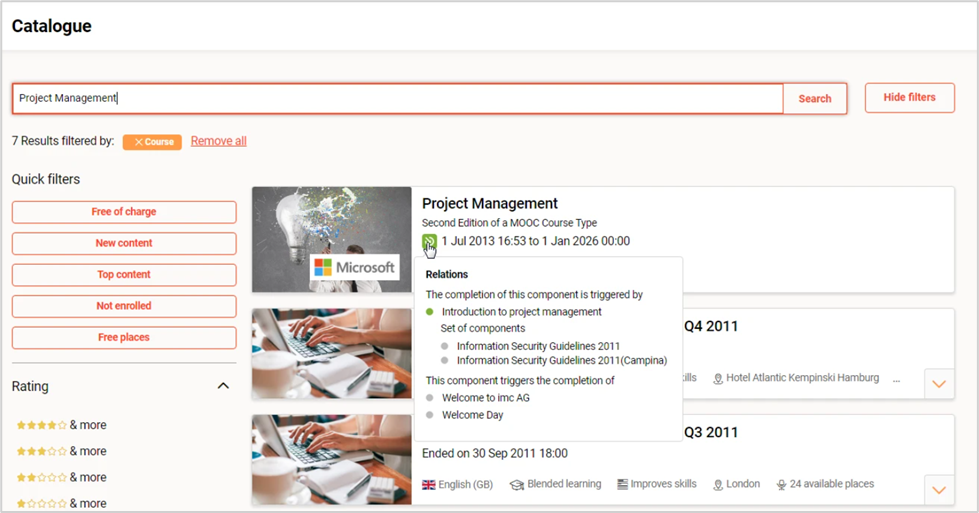
Learner catalogue view showing equivalence relations
Benefits & Use Cases: Learners can take the synergy effect of formerly completed courses into future learning requirements to avoid completing similar training just for the sake of completion; instead they will have the option to complete additional training or invest their time elsewhere.
Define relationships among courses as being equivalent to each other. Consider equivalences to mark courses assigned to the learner which have already completed equivalent course by the same learner as optional. One course is replaced by another course with updated content and the learners must not be required to re-take similar content. However, they should still be able to re-take it if they wish (A = B).
Some courses are a combination of other courses. In this case, the learner can be required to take either the overall course or the courses from that it is combined but not both (C = A + B). Currently, all equivalences are bidirectional, which means, there are no use cases where A is equivalent to B, but B is not equivalent to A. The multiple equivalence relation is possible, meaning that taking course A gives the learners credit for course B and C, taking course B gives the learner credit for both A and C, etc.
Equivalences are valid for all processes and trigger them accordingly; e.g. if a course is used as a prerequisite for another or assigned to a learning path. However, the course passed by the equivalence is not considered as a course passed directly: it does not appear in the learning history, it can still be started and completed by the learner (but it is optional and never required). Therefore, the new flag Covered is introduced.
There are 3 categories of equivalence relations that can be created:
This component triggers the completion of:
This category allows to define which objects will be considered Covered for the user if he has completed the component for which the relations are being defined. In this category it is not possible to define sets of components. All the components added in this category will be marked as Covered when the main component is completed by the learner.The completion of this component is triggered by:
This category allows to define which objects the user can complete in order to have the current object considered as Covered. In this category it is also possible to add relations as part of a set. This means that the components of a set need to be completed together in order to trigger the coverage of the main component. Objects which are defined outside of the set have an OR relationship between them. This means that by completing any of those components or alternatively the set if a set is available, the main component will be considered Covered.The completion is triggered in both directions:
Objects in this category define a mutual equivalence rule, meaning that if a learner completes the current element, he will gain coverage status in the components defined in this category, but also the other way around. Completing a component from that category will determine that the current object is set to Covered for the corresponding user.
Moreover, equivalences rules created on course level can be imported or exported.
Audience: Learners and Administrators
Setup & Access: To use this functionality, existing customers will need to configure new navigation entries as there is no automatic creation:
Open the Navigation manager, expand the Admin category, click on Content > click Create then select Structure, and in the pop-up In the hierarchy below.
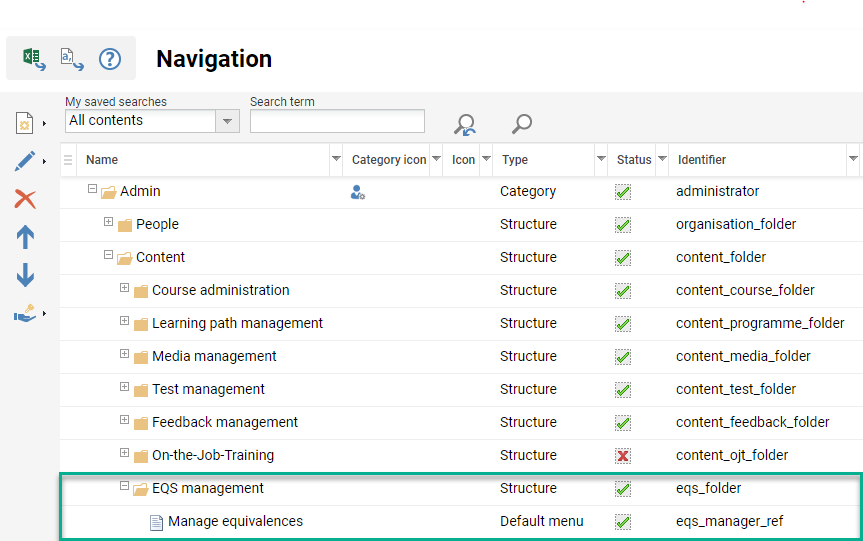
imc recommended navigation configuration for equivalences management
In the new tab set the identifier as eqs_folder, set the name as EQS management, grant access rights to the groups that will be responsible to manage equivalences, and Save.
Highlight the EQS management structure, click Create > Menu, and select In the hierarchy below.
In the new tab set the identifier as eqs_manager, the menu type as Default menu, select the default menu with identifier eqs_manager, name the menu Manage equivalences, grant access rights to required groups, and click Save and close.
Go to the Configuration manager, edit Equivalences menu, and ensure the setting Enable Equivalences is ticked.
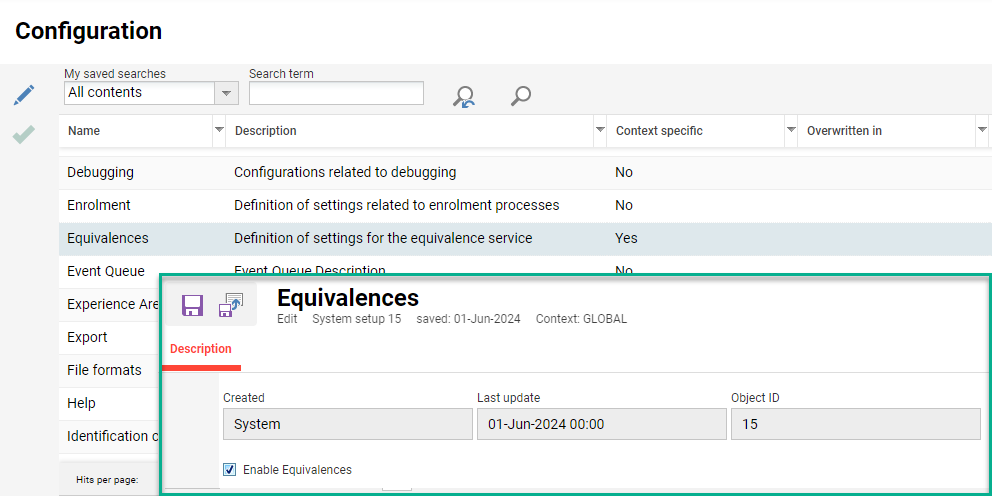
Enabling Equivalences in the Configuration Manager
Log out and back in to see the change.
Considerations & Limitations: Equivalencies becomes a core feature, with architecture automatically updated, and no migration required.
Testing: No test to check impact as the function first needs configuration.
Risk rating: Low
Media Consumption within Channels
Overview: A new report called Channel media consumption enables channel administrators to identify the accumulated number of accesses to media items assigned to channels. The new on-screen report allows filtering by specific media or media type, in defined periods, to return both accumulated results and average daily consumptions of each assigned media item.

Channel media consumption report
Benefits & Use Cases: The Channel media consumption report allows channel administrators to:
Monitor the relevancy of media in the channel,
check whether information provided through the channel reached the target group,
conclude what topics are the most relevant within a channel, and
evaluate what media types and channels are performing the best.
Audience: Administrators
Setup & Access: Channels is an add-on module that requires a license and architecture update. Customers with an active Channels license can configure as below:
The Channel media consumption report will be added to the Activities report category when the Channels license is activated. In case the Activities report category is not available, the report will need to be manually added to another report category to be visible in the Admin > Reports view.
Ensure as the groups requiring access to the report have Execute clearance on the report.
Ensure as minimum Execute clearance is granted on the channel for groups requiring to view the information on the media included in the channel.
Considerations & Limitations: Channels requires an add-on license activated and the Kubernetes architecture with the Channels micro-service installed. The following limitations apply:
The information for media is aggregated information across all versions of media.
The name of the media is shown in the administrative language of the latest published version.
The name of the channel is shown in the platform language.
The report shows the data from the time-period after the report has been delivered to the customer system. No previous Channel consumption events would have been captured in the database prior to IP22.
Paging and sorting of numerical data is not available.
Testing: For customers with an active Channels license, check clearances on the report with a System administrator and ensure the report is assigned to a Report category. Then access some media items via a Channel and open the new report to check the access, as well as other access since the patch was applied, was captured.
Risk rating: Medium
Automatic Channels Subscription
Overview: Following many requests the Channels function has been updated to channel administrators to automatically subscribe individual users, groups, or an entire client to their channel. There is also a new notification to alert users of the new subscription and they are able to unsubscribe at any time.

New Automatic subscription option in Manage clearances
Benefits & Use Cases: If someone has created a News channel, for example Our new products, and wants to make sure that all relevant people receive the news, this function will ensure that all relevant people who have a subscription to this channel, will be informed by an LMS notification.
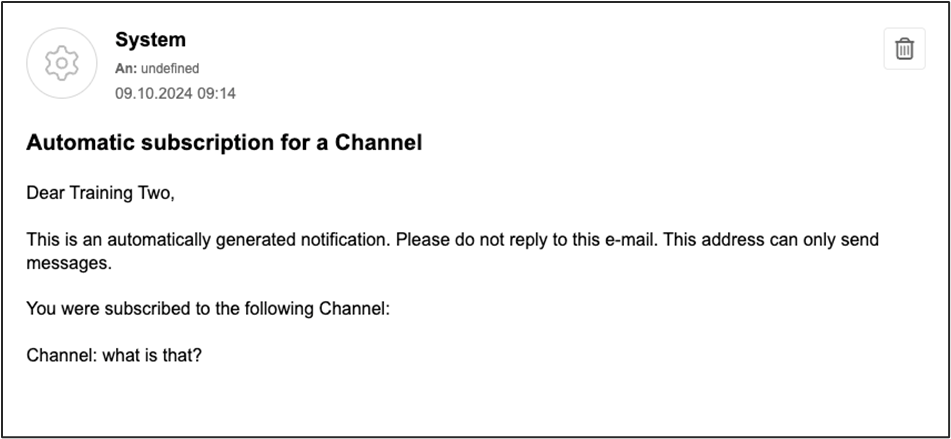
Example view of standard Channels subscription email
Audience: Learners, Channel administrators
Setup & Access: Channels is an add-on module that requires a license and architecture update. Customers with an active Channels license can configure as below: No configuration required to enable the Automatic subscription switch in the Channels Manage clearances function. The new notification called An automatic subscription has taken place would require activation in the Notifications function if desired for use.
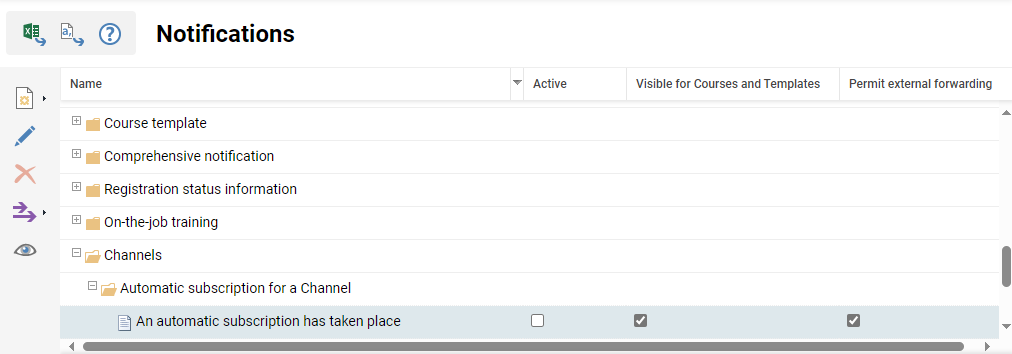
New Channels subscription notification
Considerations & Limitations: Channels requires an add-on license activated and the Kubernetes architecture with the Channels micro-service installed. The following limitations must be considered:
Users can cancel the subscription, but it is not possible to automatically re-subscribe these users.
If a group has been added for automatic subscription and new users are added to this group later on, these users will also be subscribed subsequently.
Removing users/groups/clients from the automatic subscription (after having them added initially) does not result in the subscription being removed.
Users who have already a subscription for that channel or are not in any of the groups added to this automatic subscription functionality will not be affected by the change.
If the channel was not yet published but will be published at some point in time, then the users/groups/clients will be automatically subscribed.
If users are removed from a group/client the subscription will remain.
Testing: The subscription function can be tested with a test group with minimal users assigned. Activate the An automatic subscription has taken place notification and update text as required. Then in a channel update the Manage clearances to add the test group and turn on the Automatic subscription button.
Risk rating: Low
